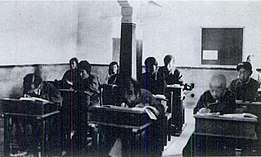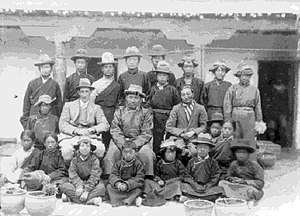Education in Tibet
Education in Tibet is the public responsibility of the Ministry of Education of the People's Republic of China. Education of ethnic Tibetans is partly subsidized by the government. Primary and secondary education is compulsory, while preferential policies aimed at Tibetans seek to enroll more in vocational or higher education.
History


Some form of institutionalized education was in place in Tibet since 860 CE, when the first monasteries were established. However, only 13% of the population (less for girls) lived there, and many still were manual laborers educated only enough to chant their prayer books. Five public schools existed outside of the monasteries: Tse Laptra trained boys for ecclesiastical functions in the government, Tsikhang to prepare aristocrats with the proper etiquette for government service. Some villages have small private schools. Some choose to educate their children with private tutors at home. In the 20th century, the government in Tibet allowed foreign groups, mainly English, to establish secular schools in Lhasa. However, they were opposed by the clergy and the aristocracy, who feared they would "undermine Tibet's cultural and religious traditions."[1] The parents who could afford to send their children to England for education were reluctant because of the distance.
Primary education

Chinese records indicate that the illiteracy rate was 90% in 1951. The Seventeen Point Agreement signed at that time pledged Chinese help to develop education in Tibet. Primary education has been expanded in recent years. Since the China Western Development program in 1999, 200 primary schools have been built, and enrollment of children in public schools in Tibet reached 98.8% in 2010 from 85%.[2] The Tibetan language class is taught in the Tibetan language, but other subjects such as mathematics, physics, and chemistry are taught in Chinese.
The Free Tibet campaign and other Tibetan human rights groups have criticised the education system in Tibet for eroding Tibetan culture.[3] There have been protests against the teaching of Mandarin Chinese in schools and the lack of more instruction on local history and culture.[4] The Chinese government argues that the education opportunities available in Tibet have improved the economic livelihood of the Tibetans.[5][6]
Higher education

The central government held the Second National Conference on Work in Tibet in 1984, and Tibet University was established the same year.[7] Tibet had six institutes of higher learning as of 2006. When the National Higher Education Entrance Examination was first established in 1980, ethnic Tibetans filled only 10% of the higher education entrant quota for the region, despite making up 97% of the region's population. However, in 1984, the Chinese Ministry of Education affected policy changes including affirmative action and Tibetan language accommodations. In 2008, the number of ethnic Tibetans sitting the National College Entrance Examination (NCEE) reached 14248, with 10211 being accepted into university, making the enrollment proportion of ethnic Tibetans 60%.[8]
See also
- Tibetan Children's Villages
- Education in the People's Republic of China
Further reading
- Alice Travers (Jan 2016). "Between Private and Public Initiatives? Private Schools in pre-1951 Tibet". Himalaya. 35 (2).
- Bass, Catriona (1998). Education in Tibet: policy and practice since 1950. Zed Books. ISBN 978-1-85649-674-2.
- "PLA contributes to better primary education in Tibet". China Tibet Online. People's Daily. 2010-02-20. Retrieved 2010-07-11.
- http://www.freetibet.org/about/education
- Policy Research Group, Trouble over patriotic education in Tibet Archived 2012-05-03 at the Wayback Machine, 26 October 2010
- Peaceful liberation: watershed of education for Tibetan people
- China Watch (China Daily) Advertising supplement in IHT, 23 May 2011
- "Facts & Figures 2002: Education". China's Tibet. China Internet Information Cente. 2002.
- Mei, Wu (2008). "The Development of Higher Education in Tibet: From UNESCO Perspective (Draft)" (PDF). UNESCO. Retrieved 2010-07-12.